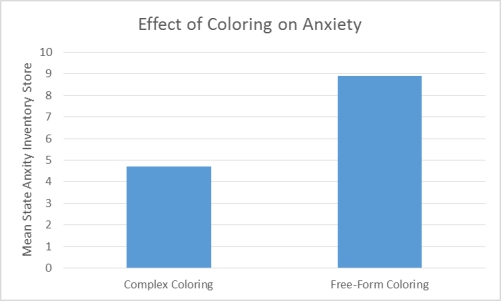Use the following to answer questions
Scenario I
Scenario I is based on fabricated data inspired by the following study:
Curry, N. A. & Kasser, T. (2005) . Can coloring mandalas reduce anxiety? Art Therapy: Journal of American Art Therapy Association, 22(2) 81-85.
Effect of Coloring on Anxiety
Curry and Kasser were interested in examining whether coloring complex geometric patterns reduces anxiety. To that end, they induced anxiety in 84 undergraduate volunteers from their university. Following anxiety induction the participants were divided into two coloring conditions. To determine which condition each participant would be in the researchers put all of their names in a hat. The first name drawn was placed in group 1, the second name drawn was placed in group 2, the third name drawn was placed in group 1, and so on. Those in the complex geometric coloring condition (group 1) were given a paper with a plaid pattern or the outline of a mandala. Those in the control condition (group 2) were given a blank piece of paper. After 20 minutes of coloring all of the participants completed a self-administered State Anxiety Inventory (SAI) . Lower SAI scores indicate low levels of anxiety whereas higher SAI scores indicate high levels of anxiety. The mean SAI scores of each coloring condition were compared to determine whether the type of coloring one does affects anxiety. The results revealed that those who colored a complex geometric pattern had significantly different levels of anxiety than those who colored on a blank sheet of paper. Curry and Kasser concluded that coloring causes a change in anxiety, but only when coloring requires a certain amount of attention and focus.
Figure 1. Effect of Coloring on Anxiety

-(Scenario I) Let's say you are skeptical of the results of this study. You set out to replicate it to determine for yourself whether coloring affects anxiety. Since you don't have access to the State Anxiety Inventory you decide to measure participants' heart rate instead. In doing this, you have changed:
Definitions:
Personal Decisions
Choices made by an individual regarding personal matters or life direction based on personal values, preferences, and circumstances.
Informed Opinions
Opinions formed based on knowledge, understanding, and critical thinking about a particular topic.
Legal System
The structure of courts and laws that a country or community adopts in order to regulate behavior and ensure justice is administered.
Medical Jargon
Specialized language used by healthcare professionals that can be difficult for non-specialists to understand.
Q11: A hybrid design occurs when at least
Q19: (Scenario I) The researchers of the study
Q34: The sensitization effect increases the likelihood of:<br>A)
Q49: Dr. Clark gave his astronomy students an
Q71: Natalia asked her college roommate, "Will becoming
Q79: Dr. Juni is organizing data from his
Q96: Dr. Coria is in the process of
Q96: Knowing what you know about sample bias,
Q139: When Dr. Wheeler was training the raters
Q157: (Scenario III) Suppose a psychologist used the